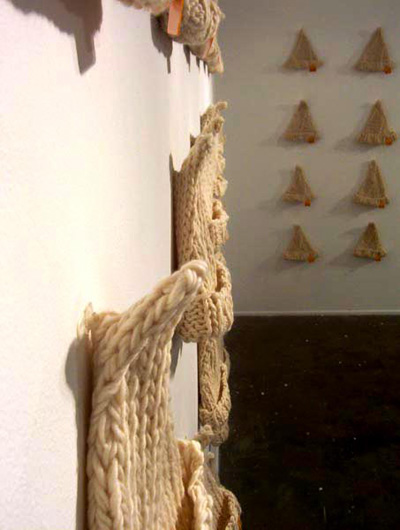 |
conference (detail), 2004
Larissa Brown (and 100 volunteer knitters)
wool & cattle tags |
Extreme Ingredients
Meatheads, Fall 2005
As I hung the last of 100 knitted wool hats
on the white expanse of art gallery wall, I
wondered what in the world I was doing. There's
a moment in art making -- many, many moments
actually -- when you doubt yourself and your
ideas completely, breathtakingly.
When I made art by myself it was hard enough
to face this kind of doubt. But this time I'd
involved a hundred innocent volunteer knitters.
Each one created a hat for me to use in an installation
called conference , for which I adorned
each hat with a numbered cattle tag. Like cows
in a meadow -- very organized cows -- the hats
dotted the gallery wall. I affectionately called
them meatheads. And they were worrying me. A
little voice was saying things like "What place
do hats have in an art gallery? It's not even
complex knitting! You didn't even knit them
yourself!"
Stepping back from the wall, I let myself be
overwhelmed by the grid of hats, and then I
felt alright again. Looking at "hats" up close
I was nervous. But standing back I saw my original
intention come to life. They weren't hats at
all. They were ingredients in a larger whole.
Each little toque was like a daub of paint,
or a scrap of paper in an enormous collage.
Sometimes viewers felt the wave of the whole
crash over them. I saw it happen and knew that
for brief moments the piece worked just as I'd
hoped.
But often viewers felt an immediate connection
with the "hatness" of the hats, and they just
never did let it go. They asked about the volunteers,
where they were from (mostly the US, England,
and Australia), whether I knew who had made
which hat (no, I didn't), and how I'd recruited
them (through my blog). My heart sunk whenever
the piece became all about hats. My worst fears
were realized when two intrepid art viewers
actually took a couple of the pieces off the
wall and tried them on their heads. I was aghast.
After all, would I take down someone's painting
and roll around in the canvas?
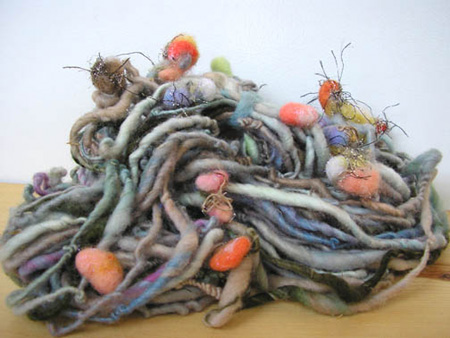 |
Bedbug
Lexi Boeger
wool and feltie sparkle critters
|
Yarn as art, yarn as ingredient
Plenty of artists are much more open to interaction
with their art -- and some have no anxiety at
all about people touching it, using it, and
even transforming it with their own hands. One
such artist is Lexi Boeger.
"I almost always intend for it to function
as both a final form in and of itself as well
as the ingredient for another work," she says
of her fat and luscious mixed media yarn. A
typical art skein from her hands might incorporate
doll parts, strips of embroidered fabric from
a thrifted muumuu, bits of nylon stockings,
or sparkly felt baubles, into a thick and thin
handspun wonder.
"I think a yarn should always be able to stand
alone. It should be able to hang on the wall
just as it is and be a satisfying, interesting,
compelling thing. And if that requirement is
met, then it will more than lend itself to going
a step, or two or ten further and evolving into
another creation."
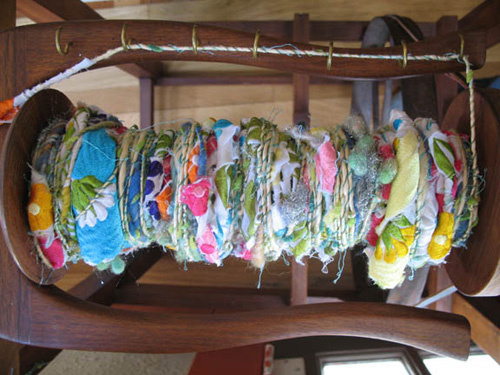 |
The Emporor Has No Clothes
Lexi Boeger
vintage muumuu, latte silk, iclandic wool,
sparkle felt nubbies and french novelty
threads
|
A knitter herself, Lexi isn't surprised when the
ball of yarn remains an intact art object. "I
really identify with the people who get it and
intend to use it, but just can't seem to find
a suitable project for it. They really are happy
to have it sitting in the yarn basket. This is
the phenomenon that drew me into spinning in the
first place....that feeling of: 'Oh. It's just
so pretty like it is.'" She accepts yarn for what
it is, and revels in its natural yum.
Meanwhile, the yarn is imbued with a sometimes
subtle -- but always present -- potential energy.
It could be something else.
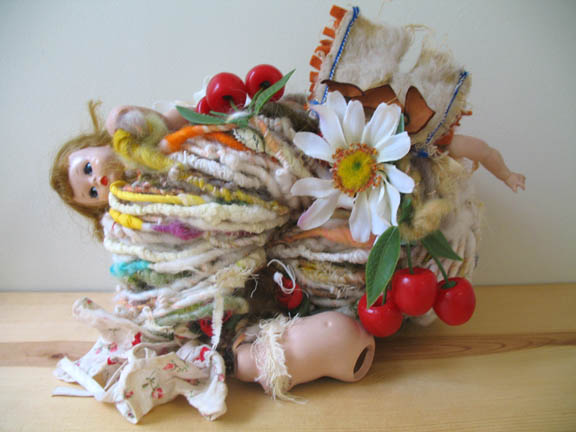 |
Prairie Dream
Lexi Boeger
white icelandic fleece, hand-dyed fibers,
silk waste, fabric, flowers, rubber cherries,
and a 1940's vintage doll with her western
chaps and prairie blouse |
Lexi's joy in embracing what happens naturally,
and trusting in the yarn's own beauty, is at
the heart of how she got started with art yarn.
"I was teaching someone to spin and their first
skein came out way over twisted in spots and
not twisted at all in others. It had tangles
and knots where they got hooked up or had trouble,
and it was the most beautiful yarn I had ever
seen. I realized that it was those instances
where the yarn diverged from 'good' spinning
that it became great spinning." Her own great
spinning is sometimes planned, but almost always
diverges.
Silkworm cocoons, rubber bands, plastic wrap,
beads, fake flowers, craft pompoms, Easter chicks,
google eyes, silk waste, granny jewelry, wire,
bathrobe, tinselŽall are transformed into skeins
of yarn that each stand out as stunning portraits
in a gallery of otherworldly creatures. But
each can also become a hat, a scarf, a pair
of fingerless mitts. And that's okay.
"Everyone has a different vision for these
yarns. It's a wonderful collaboration: having
a vision and creating a yarn then handing it
off to someone who looks at it and is inspired
to transform it into a whole new form."
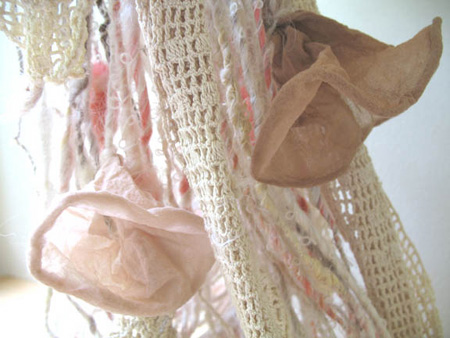 |
Era
Lexi Boeger
vintage lace crochet, pantyhose &
mohair
|
Meathead no longer
That kind of acceptance. No, that embracing
of what others bring to a work of art was a
gift I got from the conference installation. And something I've learned for life.
When I first planned the installation, I was
going to knit all the hats myself. I was afraid
to involve other people in the work, afraid
they would have a bad experience or see the
doubt in my process. They would learn the truth,
that I didn't know what I was doing, and that
I'd taken them along for the ride.
But what happened was wonderful. The volunteers
felt that I had given them
an opportunity. They were
thanking me . Envelope
after envelope arrived with meathead hats inside,
along with gifts. Gifts! Candy, tea, soaps,
even a knitted washcloth that matched my bathroom.
The generosity of the volunteers was immense
and unexpected.
But the biggest surprises were the hats themselves.
Even though they were all made from the exact
same materials and pattern, each one came alive
with its own personality. They were entirely
different from one another, in shape, form,
size, tightness, twistiness, and character.
Some were frighteningly long and strange, others
tiny little balls of anxious knitting. A few
were so freakishly shaped they became the sweet
underdogs of the grid.
Thanks to the knitters who volunteered, an
art installation that was going to be about
conforming and giving in to the world's pressures
actually became about individuality. About the
irrepressible personal spirit, and the power
of each knitter's hand in her work. I became
filled with wonder at the potential for variation
within a sea of sameness, and my work as an
artist and a crafter has not been the same since.
Lexi Boeger says it well: "The metamorphosis
that the yarn goes through connects us, ties
us together through a single strand of yarn.
It is a chain, from the farmer shearing the
wool to the person dyeing it, to the spinner,
the knitter, the artist who works it into a
shape and on to the person who wears it or holds
it or shows it."
I get it. I agree.

Lexi Boeger's web site is
pluckyfluff.com.
You can buy her art yarn there, as well as her
book about spinning, and see works in progress.

|

